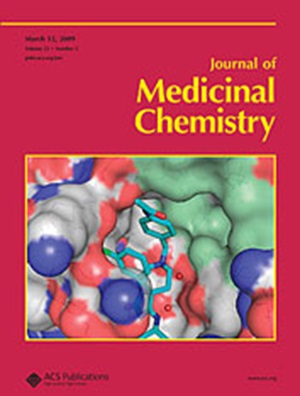Steric Hindrance-Engineered Redox-Responsive Disulfide-Bridged Homodimeric Prodrug Nanoassemblies for Spatiotemporally Balanced Cancer Chemotherapy.
IF 6.8
1区 医学
Q1 CHEMISTRY, MEDICINAL
引用次数: 0
Abstract
The rational design of tumor-responsive prodrug nanoassemblies requires precise control over systemic stability and site-specific activation. While α-position disulfide bonds are advantageous for rapid response to redox conditions, they also risk premature drug leakage during circulation. This study introduces a steric hindrance-guided approach to engineer disulfide-bridged podophyllotoxin homodimeric prodrugs for spatiotemporal controlled delivery. By monomethyl or dimethyl substitution of the carbon atoms adjacent to the α-disulfide bond, we can modulate steric hindrance. Excessive hindrance destabilizes the nanoassemblies and slows effective drug release, while moderate hindrance (monomethyl modification) enhances pharmacokinetic properties and promotes selective tumor activation. In vivo studies indicate that monomethyl-modified prodrug nanoassemblies exhibit superior antitumor efficacy and reduced off-target toxicity compared to PPT solution. This work underscores the importance of steric hindrance in optimizing prodrug nanoassembly stability and tumor-specific activation, offering a comprehensive strategy for redox-responsive nanomedicines.空间位阻工程氧化还原反应二硫桥同二聚体前体纳米组件用于时空平衡的癌症化疗。
合理设计肿瘤反应性前药纳米组件需要精确控制系统稳定性和位点特异性激活。虽然α-位置二硫键有利于快速响应氧化还原条件,但它们也有在循环过程中过早泄漏药物的风险。本研究介绍了一种空间位阻引导的方法来设计二硫化物桥接鬼臼毒素同二聚体前体药物,用于时空控制递送。通过单甲基或二甲基取代α-二硫键附近的碳原子,我们可以调节位阻。过度的阻碍使纳米组件不稳定并减缓有效的药物释放,而适度的阻碍(单甲基修饰)增强药代动力学特性并促进选择性肿瘤激活。体内研究表明,与PPT溶液相比,单甲基修饰的前药纳米组件具有更好的抗肿瘤功效和更低的脱靶毒性。这项工作强调了空间位阻在优化前药纳米组装稳定性和肿瘤特异性激活中的重要性,为氧化还原反应的纳米药物提供了一个全面的策略。
本文章由计算机程序翻译,如有差异,请以英文原文为准。
求助全文
约1分钟内获得全文
求助全文
来源期刊

Journal of Medicinal Chemistry
医学-医药化学
CiteScore
4.00
自引率
11.00%
发文量
804
审稿时长
1.9 months
期刊介绍:
The Journal of Medicinal Chemistry is a prestigious biweekly peer-reviewed publication that focuses on the multifaceted field of medicinal chemistry. Since its inception in 1959 as the Journal of Medicinal and Pharmaceutical Chemistry, it has evolved to become a cornerstone in the dissemination of research findings related to the design, synthesis, and development of therapeutic agents.
The Journal of Medicinal Chemistry is recognized for its significant impact in the scientific community, as evidenced by its 2022 impact factor of 7.3. This metric reflects the journal's influence and the importance of its content in shaping the future of drug discovery and development. The journal serves as a vital resource for chemists, pharmacologists, and other researchers interested in the molecular mechanisms of drug action and the optimization of therapeutic compounds.
 求助内容:
求助内容: 应助结果提醒方式:
应助结果提醒方式:


